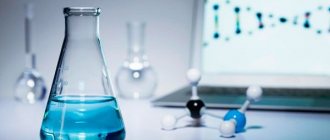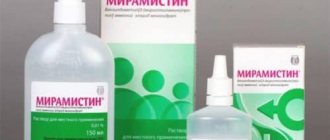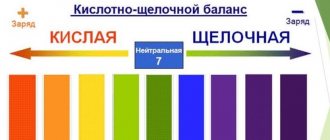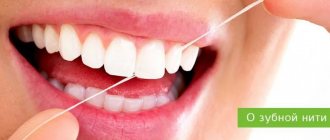Comparison of the effectiveness of Miramistin and Okomistin
The effectiveness of Miramistin is quite similar to Okomistin - this means that the ability of the drug substance to provide the maximum possible effect is similar.
For example, if the therapeutic effect of Miramistin is more pronounced, then using Okomistin even in large doses will not achieve this effect.
Also, the speed of therapy - an indicator of the speed of therapeutic action - is approximately the same for Miramistin and Okomistin. And bioavailability, that is, the amount of a drug reaching its site of action in the body, is similar. The higher the bioavailability, the less it will be lost during absorption and use by the body.
Comparison of the effectiveness of Miramistin and hydrogen peroxide
Hydrogen peroxide is more effective than Miramistin - this means that the ability of the medicinal substance to provide the maximum possible effect is different.
For example, if the therapeutic effect of Hydrogen Peroxide is more pronounced, then it is impossible to achieve this effect with Miramistin even in large doses.
Also, the speed of therapy is an indicator of the speed of the therapeutic action; hydrogen peroxide and Miramistin are also different, as is bioavailability - the amount of a drug substance reaching the place of its action in the body. The higher the bioavailability, the less it will be lost during absorption and use by the body.
Comparison of the safety of Miramistin and Okomistin
The safety of a drug includes many factors.
At the same time, in Miramistin it is quite similar to Okomistin. It is important where the drug is metabolized: drugs are excreted from the body either unchanged or in the form of products of their biochemical transformations. Metabolism occurs spontaneously, but most often involves major organs such as the liver, kidneys, lungs, skin, brain and others. When assessing the metabolism of Miramistin, as well as Okomistin, we look at which organ is the metabolizing organ and how critical the effect on it is.
The risk-benefit ratio is when the prescription of a drug is undesirable, but justified under certain conditions and circumstances, with the obligatory observance of caution in use. At the same time, Miramistin does not have any risks when used, just like Okomistin.
Also, when calculating safety, it is taken into account whether only allergic reactions occur or possible dysfunction of the main organs. In other matters, as well as the reversibility of the consequences of using Miramistin and Okomistin.
Difference between Miramistin and Peroxide
A comparison of the drugs shows that their main similarity is in the form of release. Both products are sold in solution form. You do not need a prescription to purchase them. Miramistin and Peroxide are antiseptic agents. However, there is still a significant difference in the mechanism of action.
Miramistin is a transparent antiseptic solution that destroys harmful bacteria, fungi and viruses. It gently envelops the skin, lesions and mucous membranes. The effectiveness of treatment has been confirmed even with purulent wounds. The medication almost never causes an allergic reaction and has no contraindications .
A cheaper analogue works approximately the same way: Chlorhexidine. In pediatric practice, it can be used to treat wounds on the skin, and if it is necessary to irrigate the mucous membranes, Miramistin should be preferred.
Hydrogen peroxide is a colorless antiseptic solution that should be used to treat various skin lesions. The medicine is actively used to eliminate bacteria from the umbilical fossa of infants. The principle of action of the drug is the release of atomic oxygen. This process is accompanied by hissing and the formation of bubbles, due to which harmful microorganisms, dead tissue and suppuration are eliminated.
It should be noted that Hydrogen Peroxide costs significantly less than Miramistin. However, you cannot independently replace one remedy with another.
Comparison of addiction between Miramistin and Okomistin
Like safety, addiction also involves many factors that must be considered when evaluating a drug.
So, the totality of the values of such parameters as “o syndrome” in Miramistin is quite similar to the similar values in Okomistin. Withdrawal syndrome is a pathological condition that occurs after the cessation of intake of addictive or dependent substances into the body. And resistance is understood as initial immunity to a drug; in this it differs from addiction, when immunity to a drug develops over a certain period of time. The presence of resistance can only be stated if an attempt has been made to increase the dose of the drug to the maximum possible. At the same time, Miramistin has quite a small amount of “syndrome”, however, the same as Okomistin.
Miramistin
Miramistin is an antiseptic drug for local and external use. Endowed with a wide spectrum of antibacterial action, including nosocomial microbial strains resistant to antibiotics. The drug has a pronounced bactericidal (destructive for bacteria) effect on gram-positive (Staphylococcus spp., Streptococcus spp.) and gram-negative (Escherichia coli, Klebsiella spp., Pseudomonas aeruginosa) bacteria. It has a fungicidal effect on ascomycetes of the genera Penicillium and Aspergillus, yeast (Torulopsis gabrata, Rhodotorula rubra) and yeast-like (Candida albicans, Candida krusei, Candida tropicalis, Malassezia furfur, Pityrosporum orbiculare) fungi, dermatophytes (Epidermophyton Kaufman-Wolf, Epidermophyton floccosum, Microsporum canis , Microsporum gypseum, Trichophyton mentagrophytes, Trichophyton rubrum, Trichophyton schoenleini, Trichophyton violacent, Trichophyton verrucosum) and other monocultures and associations of pathogenic fungi, including fungal microflora with resistance to chemotherapy drugs. It has antiviral activity against complex viruses (human immunodeficiency virus, herpes viruses, etc.). The drug also acts on pathogens of sexually transmitted infections (Neisseria gonorrhoeae, Chlamydia spp., Trichomonas vaginalis, Treponema spp., etc.). Effectively prevents infections of burns and open wounds. Stimulates recovery processes. Activates the occurrence of protective reactions at the site of direct use due to the activation of phagocytosis. The presence of pronounced hyperosmolar activity in Miramistin gives the drug a number of useful properties. Thus, this antiseptic is able to reduce wound and peri-wound inflammation, absorb purulent exudate, promoting the formation of a dry scab. At the same time, miramistin does not damage granulations and normal skin cells, and also does not suppress marginal epithelialization. The drug does not have irritant or allergen properties. When used topically, Miramistin is not absorbed by the skin and mucous membranes and does not enter the systemic circulation.
When used in traumatology, combustiology, surgery for therapeutic and prophylactic purposes, wound and burn surfaces are irrigated, wounds and fistula tracts are tamponed, and gauze swabs soaked in miramistin are secured. This procedure is carried out 2-3 times a day for 3-5 days. One of the most effective is the method of active drainage of wounds with a daily consumption of the drug up to 1 liter. When used in obstetric and gynecological practice, in order to prevent postpartum infection, vaginal irrigation is performed for 5-7 days before childbirth and in the postpartum period. The consumption of the drug for one such procedure is 50 ml, the exposure time is 2 hours. If the birth took place by cesarean section, then immediately before the surgical intervention the vagina is treated, during the procedure the uterine cavity is treated along with the incision made, and after the operation tampons moistened with miramistin are inserted into the vagina for 2 hours every day for 1 week. Treatment of diseases of inflammatory origin is carried out in the form of two-week courses by introducing tampons into the vagina and/or through medicinal electrophoresis. To prevent sexually transmitted diseases, Miramistin will be effective if it is used no later than 2 hours after sexual intercourse. To do this, using the included urological applicator, the contents of the bottle are introduced into the urethra for 2-3 minutes: 2-3 ml (for men), 1-2 ml and an additional 5-10 ml into the vagina (for women). The skin of the inner thighs, peripubic area and external genitalia is also treated. After this procedure, it is recommended to refrain from urinating for 2 hours. In combination therapy for urethritis, Miramistin is injected into the urethra 2-3 ml 1-2 times a day for 10 days. For inflammation of the oral mucosa and gums, as well as for periodontitis, Miramistin is used in the form of mouth rinses of 10-15 ml of solution 3-4 times a day.
Comparison of side effects of Miramistin and Okomistin
Side effects or adverse events are any adverse medical event that occurs in a subject after administration of a drug.
Miramistin's side effects are almost the same as Okomistin's. They both have few side effects. This implies that the frequency of their occurrence is low, that is, the indicator of how many cases of an undesirable effect of treatment are possible and registered is low. The undesirable effect on the body, the strength of influence and the toxic effect of Miramistin are similar to Okomistin: how quickly the body recovers after taking it and whether it recovers at all.
Comparison of the safety of Miramistin and hydrogen peroxide
The safety of a drug includes many factors.
At the same time, in Miramistin it is quite similar to Hydrogen Peroxide. It is important where the drug is metabolized: drugs are excreted from the body either unchanged or in the form of products of their biochemical transformations. Metabolism occurs spontaneously, but most often involves major organs such as the liver, kidneys, lungs, skin, brain and others. When assessing the metabolism of Miramistin, as well as of Hydrogen Peroxide, we look at which organ is the metabolizing organ and how critical the effect on it is.
The risk-benefit ratio is when the prescription of a drug is undesirable, but justified under certain conditions and circumstances, with the obligatory observance of caution in use. At the same time, Miramistin does not have any risks when used, just like hydrogen peroxide.
Also, when calculating safety, it is taken into account whether only allergic reactions occur or possible dysfunction of the main organs. In other matters, as well as the reversibility of the consequences of using Miramistin and Hydrogen Peroxide.
Comparison of ease of use of Miramistin and Okomistin
This includes dose selection taking into account various conditions and frequency of doses. At the same time, it is important not to forget about the release form of the drug; it is also important to take it into account when making an assessment.
The ease of use of Miramistin is approximately the same as Okomistin. However, they are not convenient enough to use.
The drug ratings were compiled by experienced pharmacists who studied international research. The report is generated automatically.
Last update date: 2020-12-13 10:42:47
Comparison of addiction between Miramistin and hydrogen peroxide
Like safety, addiction also involves many factors that must be considered when evaluating a drug.
So, the totality of the values of such parameters as “o syndrome” in Miramistin is quite similar to the similar values in Hydrogen Peroxide. Withdrawal syndrome is a pathological condition that occurs after the cessation of intake of addictive or dependent substances into the body. And resistance is understood as initial immunity to a drug; in this it differs from addiction, when immunity to a drug develops over a certain period of time. The presence of resistance can only be stated if an attempt has been made to increase the dose of the drug to the maximum possible. At the same time, Miramistin has a fairly small value of the “syndrome”, however, the same as for Hydrogen Peroxide.
Comparison of side effects of Miramistin and hydrogen peroxide
Side effects or adverse events are any adverse medical event that occurs in a subject after administration of a drug.
Miramistin's side effects are almost the same as those of Hydrogen Peroxide. They both have few side effects. This implies that the frequency of their occurrence is low, that is, the indicator of how many cases of an undesirable effect of treatment are possible and registered is low. The undesirable effect on the body, the strength of influence and the toxic effect of Miramistin are similar to Hydrogen Peroxide: how quickly the body recovers after taking it and whether it recovers at all.










